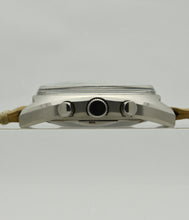
Lemania Chronograph in Stainless Steel, Ref. 9658, circa the 1970s.
Fine, stainless steel, wristwatch with round button chronograph, register and revolving bezel.
Case: Tonneau shaped, three-body, screw-down case back, crown flanked by twin round chronograph pushers.
Dial: Black dial with applied gilt metal square baton hour markers, white printed seconds and five minute divisions, black subsidiary dials for running seconds, 30 minute and 12 hour recording, white chronograph hand. Signed Lemania.
Movement: Caliber 1873 manual wind chronograph movement. 17 jewels. Signed Lemania.
Condition: Case shows no polishing, dial and hands have aged nicely and evenly. Acrylic crystal is not original and bears the Omega signature.
Diameter: 42mm, thickness: 14mm.
More about Lemania:
Alfred Lugrin was born and raised in Switzerland in the mid-19th Century, and early on started working for various watch companies designing chronograph movements. He founded his own company, called A. Lugrin S.A. in 1884, and enjoyed much success. Known for his innovative chronograph movements, Albert patented one of the movements (Brevet No. 359) and started to win awards for his designs.
In 1918, the Lemania Watch Company was created, and soon after in 1920 Alfred’s son-in-law Marius Meylan became the managing director. In 1932 Meylan purchased the Lemania company and would continue to market watches and movements under that name.
One of Lemania’s most well known movements was adopted by Omega for their chronographs, chosen for its shock protection and anti-magnetic balance spring. Introduced first in 1946 as the caliber 321, Omega went on to use this legendary caliber in its Speedmaster models. With the international recognition from the Omega Speedmaster as the first watch worn on the moon, Lemania’s chronograph movements began to appear in watches produced by Audemars Piguet, Breitling, and Patek Philippe, among others.
Over the next several decades, the ownership of Lemania changed hands several times, finally becoming part of the Swatch Group through their purchase of Breguet. Their movements are still used today in many Breguet watches.





















